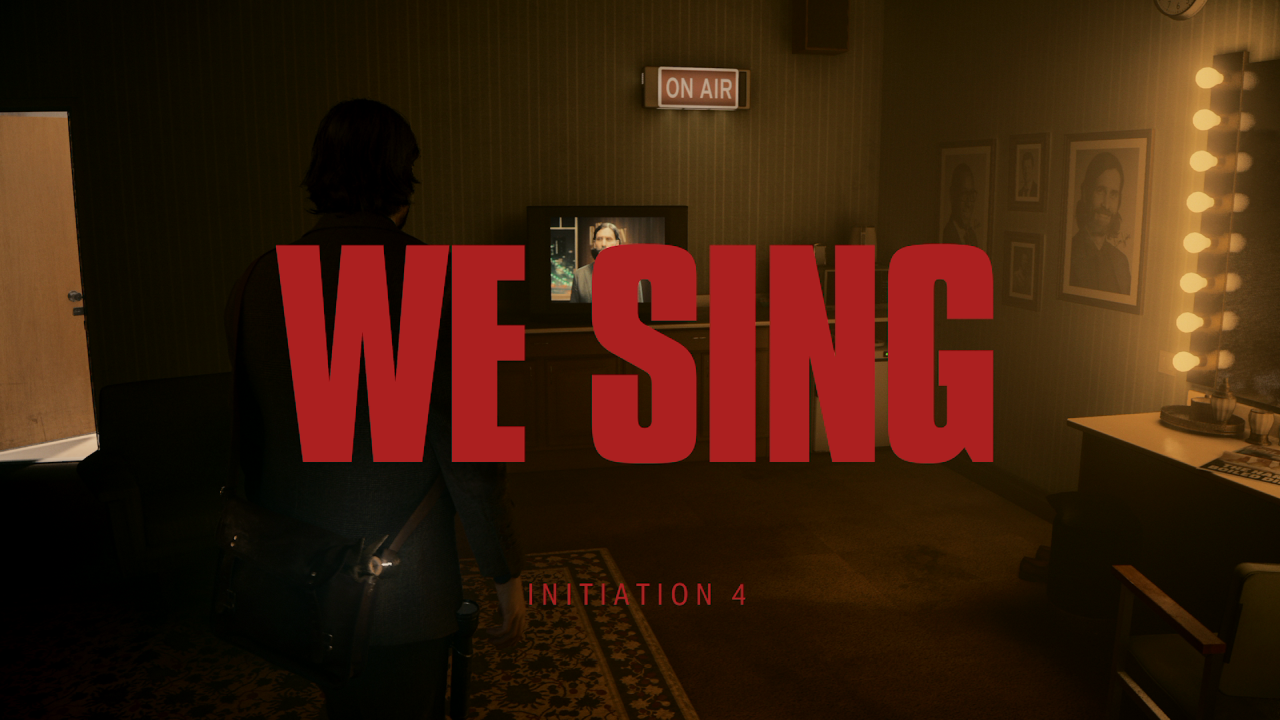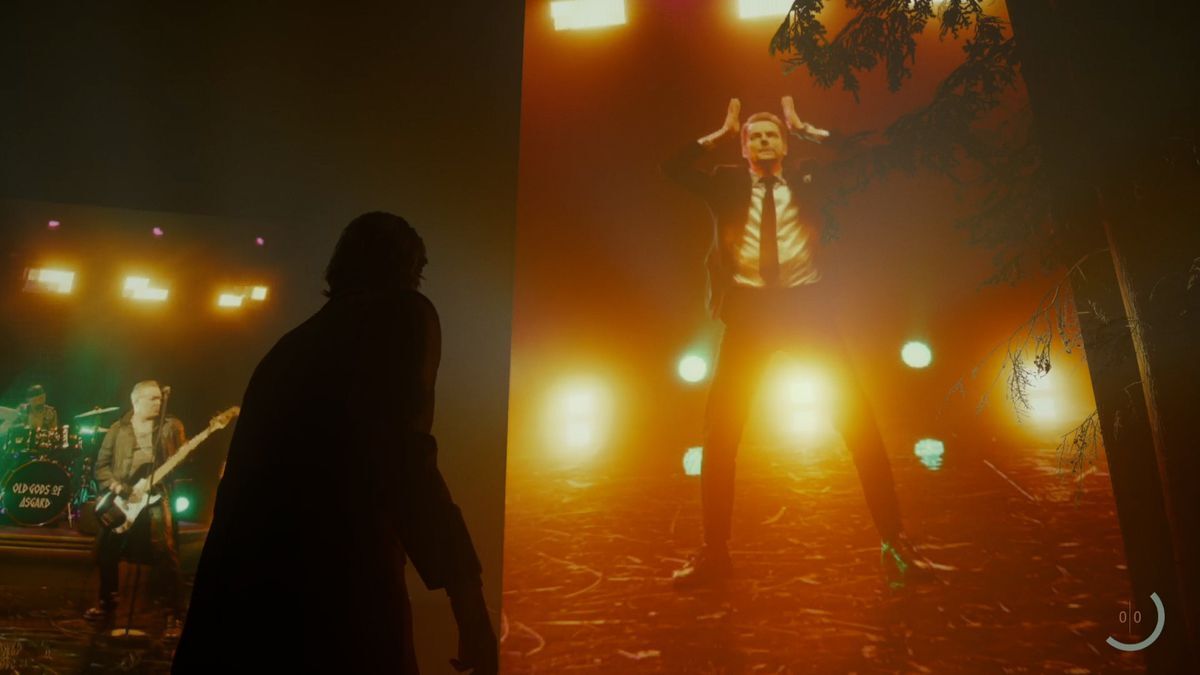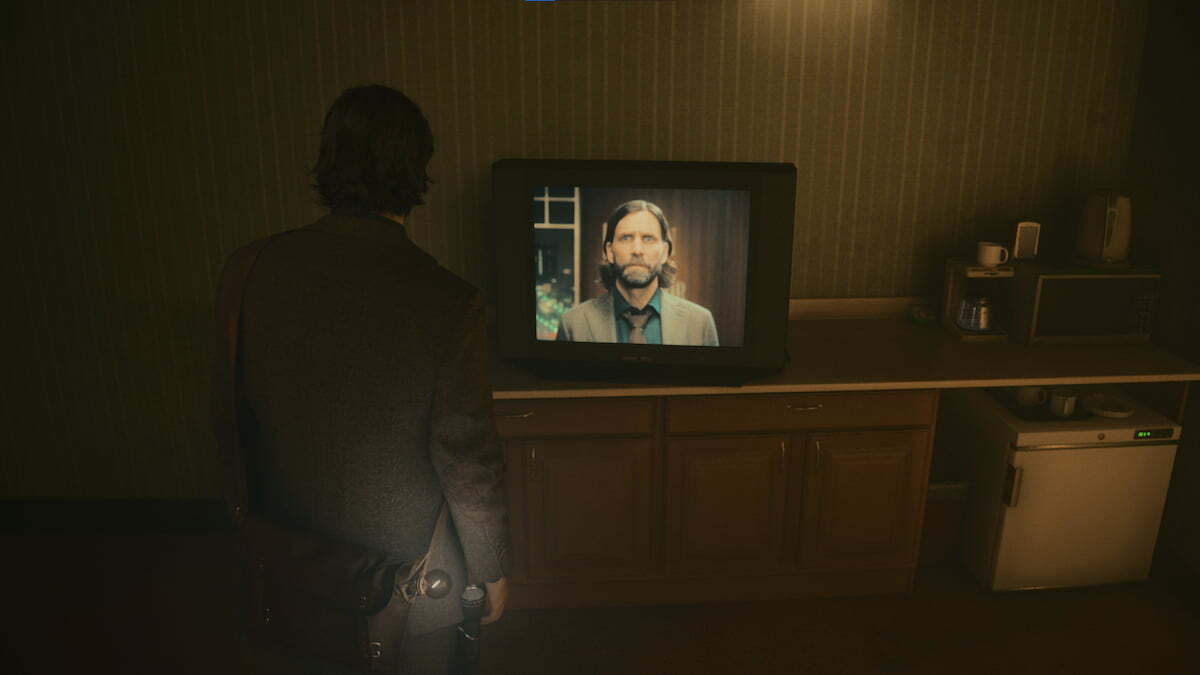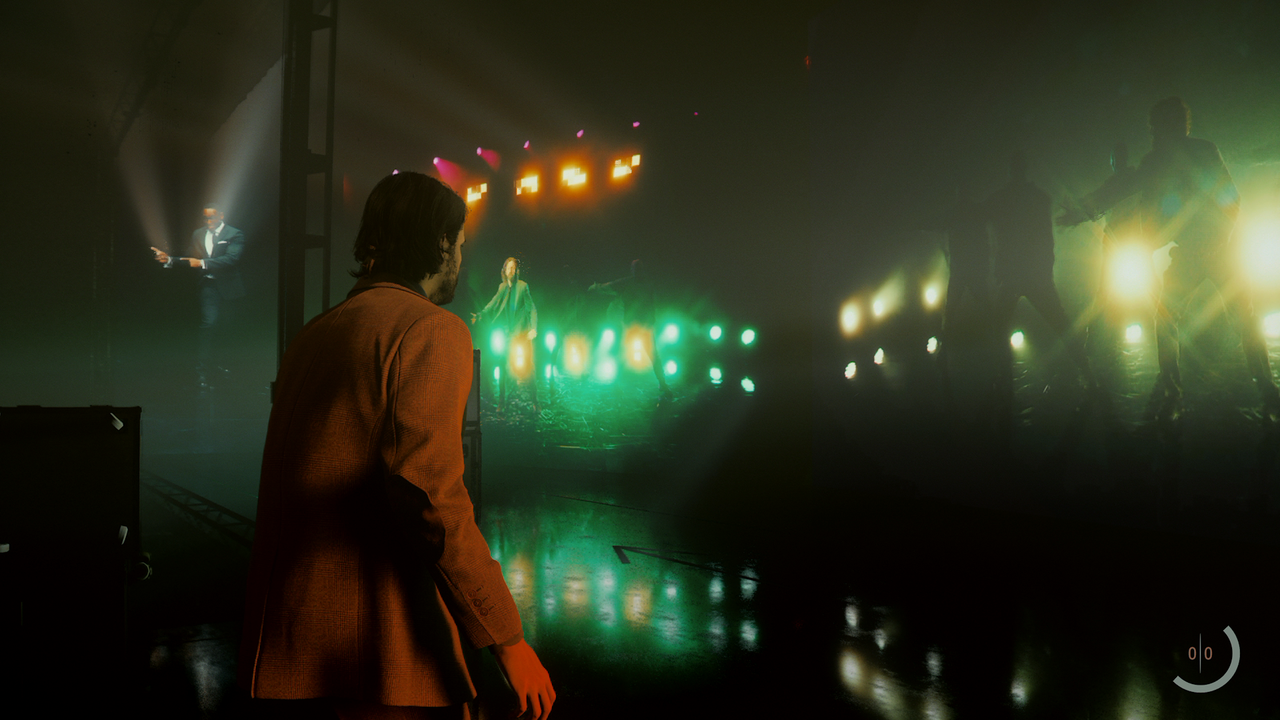Alan Wake 2 stunned us in lots of ways–how a lot it differed from its predecessor, how a lot Saga Anderson added to Alan Wake’s story, the best way Alan Wake 2 continued to essentially tie collectively all of Treatment’s video games. However the largest shock of all begins with two phrases taking over nearly the entire display:
WE SING.
WARNING: That is your likelihood to get out of right here earlier than I spoil one of many silliest, weirdest, and finest gaming moments in Alan Wake 2.
Alan Wake is caught in a loop. The Darkish Place desires to maintain him trapped and confused in order that it might use his creativity to present itself in the actual world. Time and again, Wake finds himself, with out logic or rationalization, within the inexperienced room of a late-night discuss present referred to as In Between with Mr. Door. Mr. Door is aware of why Alan is there–to discuss his new E-book, Return, which Alan did not write. In one loop, although, Mr. Door informs Alan that they should discuss his journey thus far, and that it is best in the event that they do it by tune.
What follows is probably the most enjoyable I’ve had in taking part in a narrative-driven online game in a very long time. Metanarratives–a story a couple of story, essentially–are nothing new for Alan Wake. It is sort of his entire factor. Right here, although, it turns into literal and performative in a approach it by no means has earlier than. Big LED screens with live-action footage descend from above. In entrance of you, a display displaying Mr. Door (David Harewood), the fictional host of a chat present that seemingly solely exists contained in the Darkish Place, beckons you ahead. The reflective, black flooring forward is interrupted solely by gaffer tape to direct you as you method a door standing in the course of the room, starting your wild journey by Alan’s life in musical type.
The tune itself could be very catchy and simply as literal. It is carried out by The Previous Gods of Asgard, the in-universe identify utilized by Finnish rock band Poets of the Fall, who’ve popped up in almost each Treatment sport since 2003. Mr. Door supplies musical intros to the totally different sections of the tune, whereas the Alan Wake on the display sings his personal viewpoint within the story (a lot to the confusion of the Alan Wake we’re truly controlling), full with vocals from Alan Wake’s voice (Matthew Porretta) and face (Ilkka Villi). That is quintessential musical-style music, with very literal lyrics–characters saying their emotions and ideas out loud in methods an actual particular person by no means would. The Previous Gods of Asgard lend a Seventies and ’80s ballad metal-style backing to the tune, in addition to their very own vocal monitor.
Every part occurring right here is sensible not simply to us as individuals taking part in Wake’s story, however to Wake himself, and that makes it extra convincing and immersive at the same time as the sport strips the dressings of a online game away. In his life earlier than the Darkish Presence, Wake was used to–and hated–being interviewed on late evening exhibits, and Mr. Door supplies the construction of an interview along with his interjections. The Previous Gods’ band members and their music performed an enormous function at first of Wake’s journey. It is private for each the character and the participant.

The screens that tower above you might be straightforwardly literal and metatextual as solely Treatment actually does. Alan, Mr. Door, and the Previous Gods are joined by a fourth face–Sam Lake. Sam Lake showing on this sequence means numerous issues. Lake is the artistic director at Treatment and has shepherded all of its video games from inception to publishing, appearing as director, co-director, author, co-writer, and, typically, even a personality himself. In Alan Wake 2, Lake performs the visible a part of Alex Casey (whereas James McCaffrey lends his voice–like howWake’s likeness and voice are carried out by two totally different actors), an FBI agent who occurs to have the identical identify because the hard-boiled New York detective in Alan Wake’s books, and who’s all-too-aware of the hyperlink. Lake additionally supplied his face for the unique Max Payne, and the over-the-top grimace is a meme with avid gamers to at the present time.
The “actual” Alex Casey, Saga’s companion, does not play a very enormous function in Alan Wake 2, in comparison with Alan himself and Saga. It does not make sense for simply Alex Casey to look on this sequence. However within the metatextual nature of the Alan Wake story, it is sensible for each Sam Lake–the creator of Alan Wake–and Alex Casey–the creation of Alan Wake–to seem. As Lake dances with a goofy grin on his face, it appears like he is taunting Alan from each side of Alan’s actuality, simply because the Darkish Presence each controls and is managed by Wake. I really like the best way this not solely connects Treatment’s totally different initiatives to one another, however connects Lake to his personal writing. I really feel like I can see among the struggles Lake and his crew went by whereas placing these tales collectively.

Alan Wake 2’s disconnected construction, which has Wake exploring looping actuality and experiencing the story by outdated CRT tv units, comes into play right here, too. Because the tune takes a break, a bewildered Wake finds himself standing in entrance of a tv in a black void. Upon wanting into it, he is pulled again into the tune. This does, partly, masks a loading display, but it surely’s not only a static display telling you “simply wait a second and we’ll have extra story for you.” As a substitute, it reminds us of the story-within-a-story loop Wake is trapped in. We stared into one tv to get right here, and now we’re wanting into one other. Is this actual? Was the place earlier than actual? It cleverly makes use of these transitions to place us in Wake’s personal mindset.
This interactive stage play takes us by ideas just like the Clicker and occasions from the primary sport. All through all of this, although, there’s by no means a query that you just’re on a set. You are not in an actual place, per se, however inside a creation of Wake’s thoughts designed to mess along with his notion of actuality. Even if you do discover a place with brick partitions, neon indicators, and a taxi cab, you are rapidly taken across the again of the set, with its wood backing and helps, the place theatrical tools is being saved. Once you’re offered with a model of Alan’s writers’ room and a flare gun, the background lifts up on wires. It is all edifice. On one of many screens, Lake/Casey/Payne beckons you to proceed.
Enemies emerge from the darkness to assault Wake, and that is the primary time in AW2 he is fought enemies that did not begin as shadowy silhouettes. These enemies are extra like those that Saga–and Alan himself within the unique Alan Wake–fought. They act not like manifestations of the Darkish Presence, however just like the Taken, individuals in the actual world possessed by the Darkish Presence. Other than Alan, these are the one different bodily entities on this sequence, and this shift makes them really feel a bit like actors taking part in the a part of enemies, relatively than simply enemies, deepening the sense that that is all a efficiency, interactive theater designed for one particular particular person.

After some intense fight, you discover one other tv, and also you’re lastly out. That’s, till you view one of many many visions littered all through the sport. Often, these present Alan a ghost reminiscence of Alex Casey investigating the murders within the bounds of his manuscript. This time, although, the extent round you as soon as once more rises up on cables to disclose a display of Wake dancing impishly and singing a lounge tune with the lyrics “you gotta determine it out… to carry this tune to its finish” repeating. The entire factor ends with Alan waking up again on the set of Mr. Door’s present, the place they do one final epic musical sequence with dancing and an epic guitar solo, all in stay motion. Wake sits down, exhausted, however clearly impressed. Who’s he impressed with? With himself, with Mr. Scratch, with Sam Lake? This has the potential to make the entire thing really feel self-congratulatory, but it surely’s particularly Wake responding to it, relatively than the sport simply telling us what to suppose.
As a substitute of making an attempt to be immersive, this sequence calls consideration to itself as a set piece in probably the most literal sense. We regularly use that term–set piece–to describe massive occasions in video games. It really works right here, too, however these moments have been by no means items on a set, they have been all supposed to be handled as actuality—till this reality-bending efficiency. It unites so many issues about Alan Wake and Treatment video games.

Wake’s metanarrative story is on show right here, however so is Treatment’s fixed experimentation with storytelling. Max Payne used voiced comedian guide panels to inform its story. Alan Wake’s American Nightmare put Ilkka Villi in live-action units as each Wake and Mr. Scratch. Quantum Break featured complete tv episodes. Management’s Jesse Faden talked on to us not as a viewer however because the supply of her particular powers. She encountered ghostly visions delivered in summary live-action as she realized concerning the Federal Bureau of Management’s historical past. Max Payne 2 ended with a Poets of the Fall tune, Alan Wake featured a significant set piece–incidentally additionally on a stage, however a lot much less metatextual–backed by an Previous Gods of Asgard tune, and a composition by the Previous Gods was proven in Management to have paranatural energy. Right here, they’re actually part of the story not simply because the outdated has-been exhausting rockers that Saga meets, however as their youthful selves, nonetheless as an energetic band.
All of it appears like a reward for the participant, presenting so many dangling items of Wake’s story and tying them collectively in a approach that’s self-referential however self-effacing. There’s by no means a second the place I questioned if Treatment knew what it was doing with this sequence. So typically, the participant is merely the buyer and the viewers, however right here Treatment is together with us within the course of, remembering that we have been right here for all of this. It is continuously enjoyable and stunning, but it surely additionally acts as a historical past of Alan Wake and Treatment Video games itself–and it is meta–and steel–as hell.
